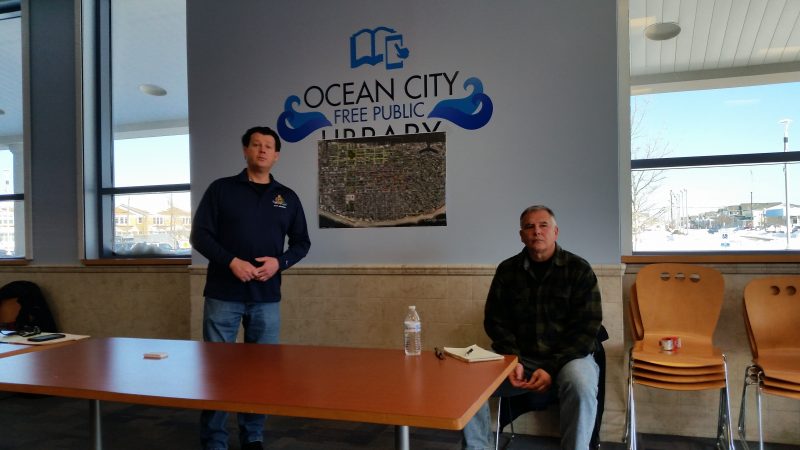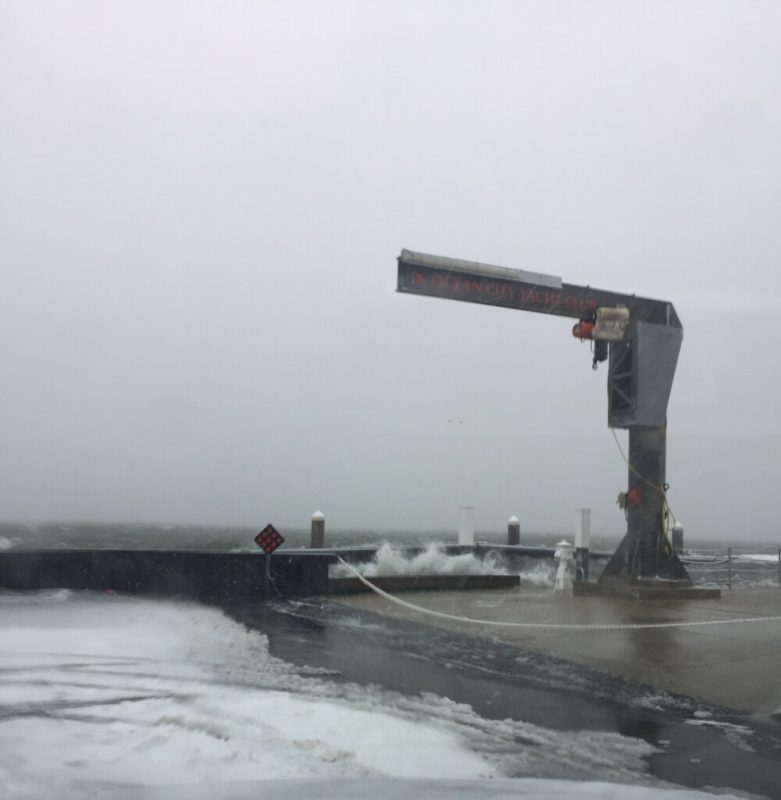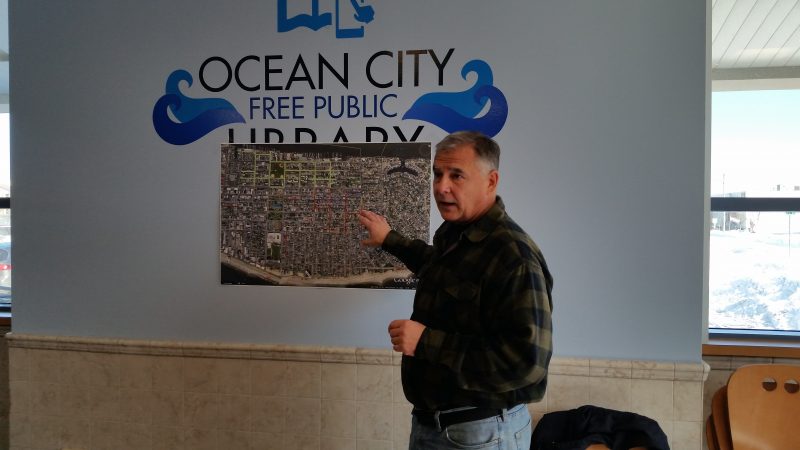Using a map, Bekier points to the 20-block area that will receive the $7.9 million worth of new drainage, pumping and road improvements.
 By Donald Wittkowski
Amid the howling winds and swirling snow during Thursday’s blizzard, Jackie McLeer and her sister, Mary Crane, could hardly believe it when they saw large chunks of ice floating down the street in the flood waters.
“My sister said, ‘Oh, my God, water is coming over the bulkhead at the bay. There are icebergs,’” McLeer recalled.
Although miniature icebergs are certainly unusual, McLeer lamented that flooding is all too common in the neighborhood surrounding her Third Street home in the north end of Ocean City.
However, new pumping stations, pipes and road improvements are planned for this flood-prone area of town as part of a $7.9 million drainage project outlined by city officials Saturday during a public meeting organized by First Ward Councilman Michael DeVlieger.
“We feel blessed that it’s finally coming to fruition,” McLeer said.
During high tides and rainstorms, the surrounding neighborhoods are plagued by nuisance flooding that has frustrated homeowners for years.
The new drainage project includes three new pumping stations to flush storm water off the streets and into the bay. The pumping stations will be built along the bayfront at Second, Fifth and Sixth streets.
“The pumps are something to get the water out significantly quicker,” said Vince Bekier, aide to Mayor Jay Gillian.
By Donald Wittkowski
Amid the howling winds and swirling snow during Thursday’s blizzard, Jackie McLeer and her sister, Mary Crane, could hardly believe it when they saw large chunks of ice floating down the street in the flood waters.
“My sister said, ‘Oh, my God, water is coming over the bulkhead at the bay. There are icebergs,’” McLeer recalled.
Although miniature icebergs are certainly unusual, McLeer lamented that flooding is all too common in the neighborhood surrounding her Third Street home in the north end of Ocean City.
However, new pumping stations, pipes and road improvements are planned for this flood-prone area of town as part of a $7.9 million drainage project outlined by city officials Saturday during a public meeting organized by First Ward Councilman Michael DeVlieger.
“We feel blessed that it’s finally coming to fruition,” McLeer said.
During high tides and rainstorms, the surrounding neighborhoods are plagued by nuisance flooding that has frustrated homeowners for years.
The new drainage project includes three new pumping stations to flush storm water off the streets and into the bay. The pumping stations will be built along the bayfront at Second, Fifth and Sixth streets.
“The pumps are something to get the water out significantly quicker,” said Vince Bekier, aide to Mayor Jay Gillian.
 First Ward Councilman Michael DeVlieger, left, and Vince Bekier, aide to Mayor Jay Gillian, explain the drainage project to north end residents.
Bekier joined DeVlieger in giving an overview of the project to about 20 north end residents during a presentation at the Ocean City Free Public Library. Also attending the meeting were Councilmen Bob Barr, Keith Hartzell and Peter Madden, Planning Board member Terry Crowley and the city’s public information officer, Doug Bergen.
DeVlieger, who represents the north end, called the drainage project a “game-changer” that will dramatically reduce flooding in a 20-block area. The drainage improvements are planned between Second and Eighth streets from West Avenue to the bay.
“It’s a big deal,” DeVlieger said.
Construction is tentatively scheduled to begin in mid or late February and take 270 days to complete. Bekier indicated that work may stop during the traditionally busy summer tourism season. City officials are meeting next week with the contractor, L. Feriozzi Concrete Co. of Atlantic City, to discuss the construction schedule.
First Ward Councilman Michael DeVlieger, left, and Vince Bekier, aide to Mayor Jay Gillian, explain the drainage project to north end residents.
Bekier joined DeVlieger in giving an overview of the project to about 20 north end residents during a presentation at the Ocean City Free Public Library. Also attending the meeting were Councilmen Bob Barr, Keith Hartzell and Peter Madden, Planning Board member Terry Crowley and the city’s public information officer, Doug Bergen.
DeVlieger, who represents the north end, called the drainage project a “game-changer” that will dramatically reduce flooding in a 20-block area. The drainage improvements are planned between Second and Eighth streets from West Avenue to the bay.
“It’s a big deal,” DeVlieger said.
Construction is tentatively scheduled to begin in mid or late February and take 270 days to complete. Bekier indicated that work may stop during the traditionally busy summer tourism season. City officials are meeting next week with the contractor, L. Feriozzi Concrete Co. of Atlantic City, to discuss the construction schedule.
 During the blizzard, the floating dock at the Ocean City Yacht Club rocks in the storm water surging above the bulkhead.
The north end project is similar to major drainage improvements built by the city to ease flooding in the Merion Park section and the central part of town between 26th and 34th streets.
DeVlieger has raised the possibility of the city working with local marinas and homeowners to build new bulkheads or improve the existing ones as another way to fight bayfront flooding.
The contractor will begin by tearing up the streets to install new pipes. The streets will then be regraded and repaved. Third Street, one of the lowest-lying areas in town, will be elevated by nearly 2 feet to protect it from flooding.
Jackie McLeer, 65, a retired federal employee, has lived on Third Street for six years. Her 67-year-old sister, Mary Crane, has been there for 20 years, using the house as a summer residence.
McLeer explained that loads of sand and river rock have been placed around the house to shield it from storm waters.
“The frustration we encounter is when people drive through the flooding and create waves of water,” she said.
The waves have penetrated her garage, damaging the home and adding to the misery already caused by the flooding, McLeer noted.
But now, McLeer is hopeful the flooding will be alleviated by the drainage project.
During the blizzard, the floating dock at the Ocean City Yacht Club rocks in the storm water surging above the bulkhead.
The north end project is similar to major drainage improvements built by the city to ease flooding in the Merion Park section and the central part of town between 26th and 34th streets.
DeVlieger has raised the possibility of the city working with local marinas and homeowners to build new bulkheads or improve the existing ones as another way to fight bayfront flooding.
The contractor will begin by tearing up the streets to install new pipes. The streets will then be regraded and repaved. Third Street, one of the lowest-lying areas in town, will be elevated by nearly 2 feet to protect it from flooding.
Jackie McLeer, 65, a retired federal employee, has lived on Third Street for six years. Her 67-year-old sister, Mary Crane, has been there for 20 years, using the house as a summer residence.
McLeer explained that loads of sand and river rock have been placed around the house to shield it from storm waters.
“The frustration we encounter is when people drive through the flooding and create waves of water,” she said.
The waves have penetrated her garage, damaging the home and adding to the misery already caused by the flooding, McLeer noted.
But now, McLeer is hopeful the flooding will be alleviated by the drainage project.
 Using a map, Bekier points to the 20-block area that will receive the $7.9 million worth of new drainage, pumping and road improvements.
Representatives of Michael Baker International LLC, the city’s flooding consultant, said during a community meeting with north end homeowners last August, that the project will handle the “nuisance level flooding” that often occurs in the surrounding neighborhoods during rainstorms and high tides.
They stressed, though, that the drainage work and new pumping stations will not be enough to stop heavy flooding unleashed by major coastal storms, such as the nor’easter Jonas in 2016 and Hurricane Sandy in 2012.
“It’s not going to cure flooding. But this project will move the water out much faster during heavy rains and that sort of thing,” Bekier said Saturday. “If it works the way it is designed, it will provide significant relief.”
Using a map, Bekier points to the 20-block area that will receive the $7.9 million worth of new drainage, pumping and road improvements.
Representatives of Michael Baker International LLC, the city’s flooding consultant, said during a community meeting with north end homeowners last August, that the project will handle the “nuisance level flooding” that often occurs in the surrounding neighborhoods during rainstorms and high tides.
They stressed, though, that the drainage work and new pumping stations will not be enough to stop heavy flooding unleashed by major coastal storms, such as the nor’easter Jonas in 2016 and Hurricane Sandy in 2012.
“It’s not going to cure flooding. But this project will move the water out much faster during heavy rains and that sort of thing,” Bekier said Saturday. “If it works the way it is designed, it will provide significant relief.”